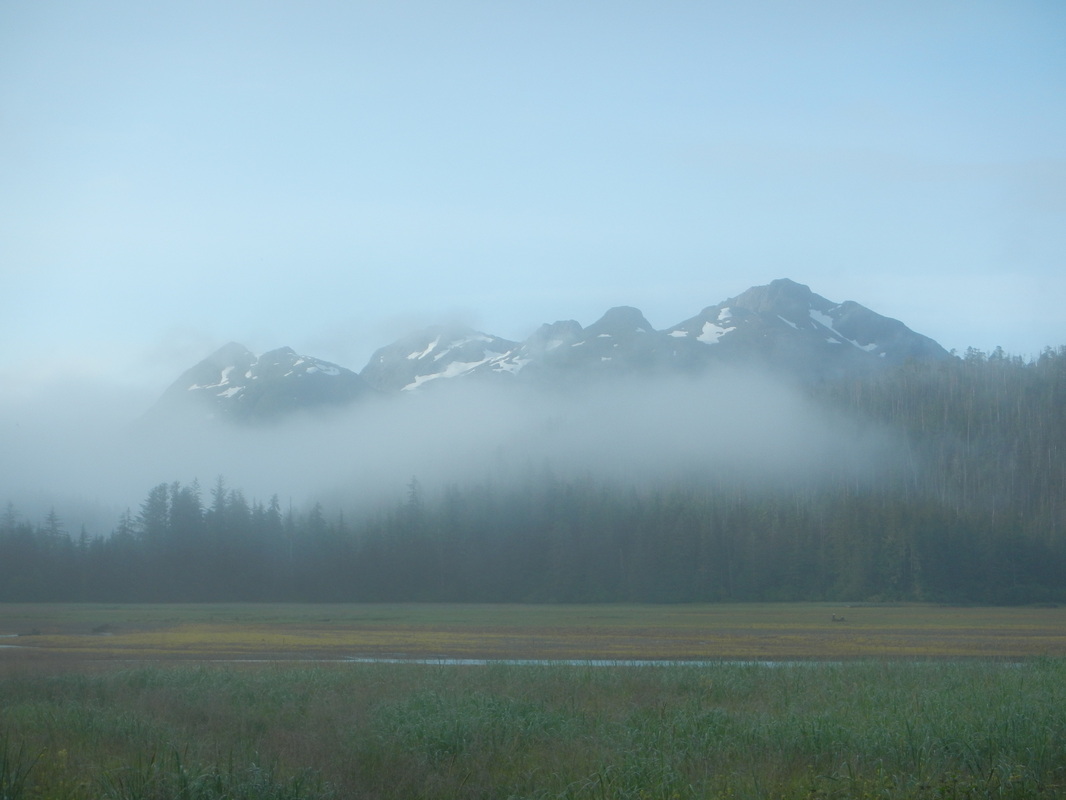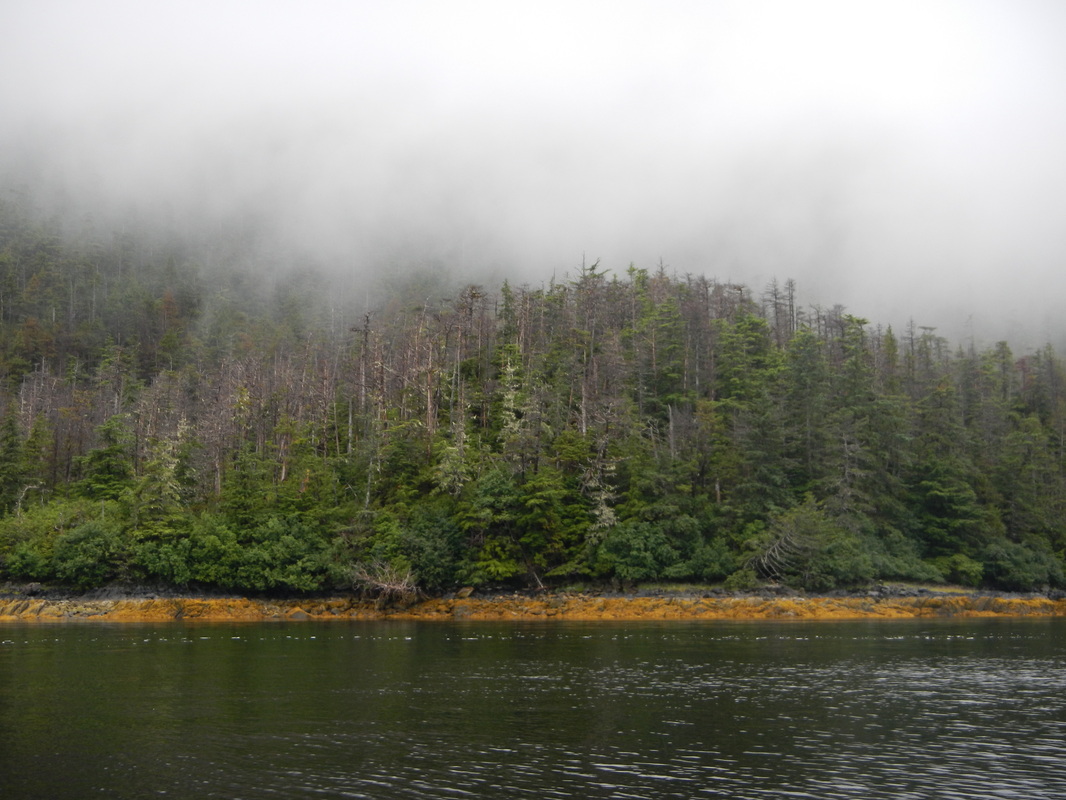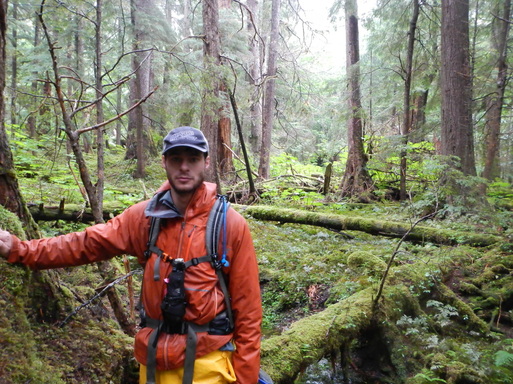“I have been in the field for fifteen days, and it has not stopped raining. The algal bloom that started growing on my outdoor research shirt has now taken over and is visible throughout the majority of the fabric. Nothing is dry. The stench has grown so intolerable that I fight off gags as I put on my clothing each morning, and tell myself that the stinging in my eyes is normal. The weather report is calling for more rain, and my mood is falling with each drop that is testing my Big Agnes tent and making me resist the inevitable exit from its shelter.”
I have recently returned from an experience of a lifetime on West Chicagof Island in the Tongass National Forest. Working with Stanford University Ph.D candidate, Lauren Oakes, ASC is taking part in a study of the dying yellow-cedar forests of SE Alaska. What I saw in SE Alaska was shocking. These trees which are primarily harvested and utilized for their fine lumber are dead. In what is one of the most tangible results of a changing climate that I have witnessed, I spent the last three weeks amongst the scant remains of a once thriving forests. As winter snowpacks have diminished, the trees whose root systems are no longer protect by the snow have become vulnerable to wind and cold events that continue to hammer the rugged coast. The phenomenon has already started spreading to the north, and scientists and resource managers are fearful that the once prolific tree species will continue dying at extraordinary rates.
While the die-off of the yellow cedar is certainly astonishing, I found myself highly aware of the wildlife situation there as well. The Greater Yellowstone Ecosystem, where I live and where I have always thought there were a lot of bears, spans an area of about 28,000 square miles and is home to an estimated 600 grizzly bears. The ABC islands, where the study in Alaska is taking place, span about 5,300 and is home to an estimated 6,000. The results of this incredible density of bears (more than 50x) is pretty striking. All native predators and many prey species have been extirpated from the area as a result of their interactions with the bears. Wolves, foxes, coyotes, moose, elk, bighorn sheep,and black bear are all absent from the ecosystem. Sitka blacktailed deer and brown bear, that is all that is left. I have followed countless game trails in my life. Walking along the path of elk or deer has always made travel easier as I move through some of the world’s most remote forests. This expedition marked the first time that I followed bear trails. Bear highways is perhaps a more accurate description. They are the only way to move through the dense forest full of false Azalia, huckleberry, and the dreaded Devil’s Club. The frequency at which bears must travel a particular route in order to have it become one of these highways is high! Once a week? Once a day? Throughout the three weeks, we saw only six bears, including one encounter with a sow and three cubs just feet from us across a salmon-filled river. A combination of us constantly making noise and the fact that the bear population is a hunted population full of skittish bears, means that we had fewer encounters than expected. With more bear sign than I have ever previously seen in every place we visited on the island, I was happy to have a shotgun, bear spray, sound horns, and to be sleeping inside an electrified fence that we presumed would somehow keep 1000lb bears out.
While the lack of diversity was striking on land, this is more than made up for in the sea. Sea lions, seals, otters, humpback whales, chinook and pink salmon, and the countless bald eagles feeding off of them are seen throughout the area on a daily basis. Often closer than you might expect.
August 12th, 2012
“When I finally pulled out from the old and abandoned mining town of W. Chicagof, immediately I saw two stellar sea lions were trailing the rest of the group. I saw them playfully rising up just feet from the double kayak, I thought of the story I had heard earlier in the week ‘Sea Lions have been known to flip kayaks.’ I paddled hard to catch up. It had begun raining and the wind had picked up considerably from the glass calm seas we had earlier in the day. When I got to the area I had last seen them, I stopped and listened with my head whipping around 180 degrees at a time hoping for a rare chance to catch a glimpse. In seconds, an explosion of air just 25 feet from my boat signaled the two 900lb. creatures bursting their heads out of the water, one rising more than halfway up his body. They returned to the water with a splash so close, it landed on top of my deck. I watched as the bubbles from their underwater movement came even closer to me, and woooosh…15ft….the warnings of flipped boats now echoing in head as they rolled back into the sea. I could smell the fish on their breath as I braced my legs up against the sides of the kayak. I frantically searched the water beneath my kayak trying to catch any extra warning before ending up upside down. The rest of our group had kept going, not knowing about happenings behind them. For nearly three miles the two sea lions and I followed one another as I paddled back to our camp. They poked their heads above water mere feet from me each time, they scared me each time, and each time, I fell further in love with Alaska.”
As I have worked the countless hours at making ASC a reality over the last year and a half, sending more than 1000 athletes out collecting data for more than 100 scientists, I have pictured myself on those expeditions, some of them more wild and daring than the experiences I have had. This expedition was a milestone for ASC in many ways. It was the first major expedition I have taken part of exclusively on an “official” nature for ASC. It was the first time that I have left my baby (ASC) behind in the capable hands of our staff (which I will say did a stellar job), and it was the first time since founding ASC, that I have had an extended period in the woods to reflect on where it has come. I am reminded of why I started ASC to begin with, and reminded of how much I admire the athletes who come to us wanting to do more with their time outside. The selfish feeling I had while on the Appalachian Trail has led on a pretty clear path to this journey. As I prepare for the trip early next year in Mongolia, where I will ski almost 400 miles in pursuit of wolverine DNA, and for returning to Southeast, AK next summer, I am proud to say that my experience in the outdoors will indeed make a difference. I am hopeful that you will all make the choice to make a difference the next time you get after it.
For more information on Lauren Oakes’s project, read her NY Times Green Blog at.
https://green.blogs.nytimes.com/author/lauren-e-oakes/



